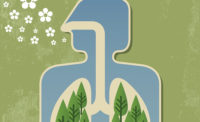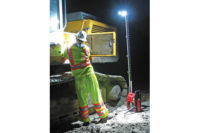Hazard evaluation
Review results of the hazard assessment with the safety department and identify the location and type of hazards. This phase of the decision process is the most important step to assure the proper selection of the airline respirator and Grade-D breathing air system to use.
Respirator selection choices
Selecting the appropriate airline respirator will require the aid of trained safety equipment distributors or manufacturer’s professionals.
A note to remember is that all airline respirators are positive pressure supplied air respirators. Airline respirators are broken into two types of devices called constant flow or pressure demand. The constant flow (CF) airline respirators are available with a tight-fitting mask or a hood design used for painters and sandblasters; these respirators operate on low air pressure from 5-30 psi. Pressure demand (PD) airline respirators are available with a tight-fitting mask or a special version PD comes with a five-minute escape cylinder. These escape PD units are required to be used in IDLH (Immediate Dangerous to Life or Health) locations. PD respirators operate at higher air pressure from 60-120 psi. When selecting and designing a breathing air system, federal regulations (OSHA/NIOSH) require that all airline respirators are supplied with a minimum of 4 cubic feet of air per minute (CFM) delivered to each worker; if the job requires sandblasting or paint hood style respirators, these respirators require minimum 6 CFM. Federal standards require that the maximum air flow (CFM) cannot exceed 15 CFM to a single airline respirator.
Calculating air (CFM) requirements
The total number of airline workers plus air tools to be used at the work location will determine the size of the compressor required to provide breathing air to operate the workers’ airline respirators. The number of workers multiplied by the required flow rate per respirator will determine the size of the air compressor. The compressor selected must deliver air consumption for each respirator and tools that will determine the overall (CFM) size of the compressor. An additional 10-15 percent output capacity (CFM) should be added to the overall compressor system for any unforeseen air consumption needs. Always calculate the average air flow requirements for each worker approximately 10-12 CFM per worker.
Selecting air choices
Now, select the air source:
1. Can the plant provide for adequate air (CFM) for our job?
2. If the location cannot provide an air source, secure a portable compressor.
3. If choice 1 or 2 are not available, compressed breathing air cylinders are available from a gas distributor.
Supplying breathable air
Air Choices 1 and 2 require the use of a Grade-D filtration system. Grade-D is filtered air that is specified by the Compressed Gas Association (CGA) and accepted by OSHA. The components of a Breathing Air System:
1. Air Source: Air can be supplied from electric, gas or diesel compressors.
2. Grade-D Filtration (with CO Monitor): Portable or fixed Grade-D filtration units will provide breathable air to the workers. Select a filtration system that will provide automatic drains to remove oil and water, and the system should provide separate filter units to remove water, oil, and a separate filter for charcoal to remove odors and tastes. Select a filtration system based on the listed CFM capacity of the unit and not by the number of workers. Some manufacturers only provide filtration units that will supply the minimum required 4 CFM to a respirator; workers may require 15 CFM to a respirator hood. The most toxic and hazardous portion of Grade-D air component is Carbon Monoxide (CO). A CO monitor device is set to alarm workers at 10 ppm if there is high CO. The alarm will allow workers to stop and determine what is causing high CO. (Always calibrate the CO monitor prior to use as this is the only way to assure that the monitor is reading correctly.)
3. Air Distribution: The filtered air must be set to the required air pressure to operate the respirator; this uses an air regulator, pressure gauge, a safety relief valve and the respirator’s couplings.
4. Respirator: The final part of the Breathing Air System is the airline respirator attached to the Air Distribution fittings with a hose; the respirator hose has a maximum of 300 ft. from the Air Distribution.
Air Choice 3 requires that workers must use pressure demand airline respirators when the air source is supplied from compressed breathing air cylinders. High pressure breathing air cylinders can be rented from a gas distributor or tanks can be filled from a high pressure compressor.
Beyond the basics
If you understand the basics of a Supplied Air System, this knowledge can allow you to design a safe breathing air system for one person or more than 100 workers. If you have special filtration needs because of the job requirements, always contact a manufacturer that can build specialized units to resolve issues of unforeseen hazards.



